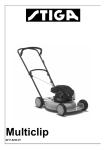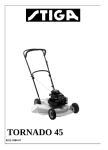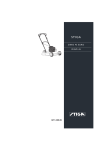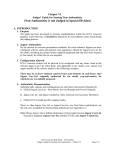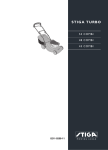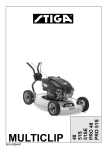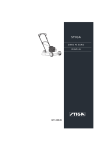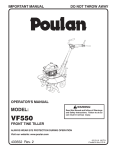Download Stiga TURBO 8211-0208-08 User's Manual
Transcript
DEUTSCH Tu r b o 8211-0208-08 D S SVENSKA B 1. 2. D F E 3. 4. 5. 6. 7. S FULL SVENSKA FULL ADD ADD ADD FULL 0,15 l. 8. Briggs & Stratton LS 45 9. Briggs & Stratton ES 45, XTE 50 FULL/MAX 3x ADD/MIN 10. Honda GCV 11. Briggs & Stratton LS 45 3x 12. Briggs & Stratton ES 45 13. Briggs & Stratton XTE 50 G STOP I* B 14. Honda GCV 15. S SVENSKA X 16. Y 17. 18. 19. Vänster / Left 20. Höger / Right 21. Briggs & Stratton LS 45 22. Briggs & Stratton ES 45, XTE 50 Briggs & Stratton : 0,76 mm 0,75 mm Honda: 0,7-0,8 mm 23. Honda GCV 24. S SVENSKA 25. 26. S S 27. 28. T U 29. 31. 40 Nm 30. GB ENGLISH SYMBOLS 3 STOP The following symbols are displayed on the machine in order to remind you about the safety precautions and attention necessary when using the machine. 2 1 5 The symbols mean: Warning! Read the Instruction Book and Safety Manual before using the machine. 4 Warning! Keep spectators away. Beware of objects being flung out. Type II 3 2 STOP Warning! Do not put hands or feet under the cover of the machine when it is running. 1 Warning! Before starting any repair work, remove the spark plug cable from the spark plugs. IMPORTANT 4 Type III Equipment marked with an asterisk (*) is included as standard equipment only for certain models or specific country versions. 1. Throttle (*) 2. Coupling clamp (*) 3. Start/Stop clamp 4. Electric starting facility (*) 5. Variator lever (*) Certain models do not have a throttle. The engine speed is set for optimal function and minimal exhaust emissions. INTRODUCTION 3 PARTS PACKED SEPARATELY IN CARTON STOP 2 1 4 ASSEMBLING 2 Grass collector retainers 4 Screws for retainers 1 Starter key (*) 1 Battery charger (*) 1 Allen key 1 Socket wrench + Instruction Manuals HANDLE 1. Fold up the lower part of the handle. Type I 2. Mount the upper part of the handle with screws, washers and locking nuts. On the right-hand side, mount an eyelet for the starter handle (fig. 1). GB ENGLISH 3. Tighten the locking nuts to the lower part of the handle. When these are tightened, the height of the handle can be adjusted by tightening the screws B with the enclosed wrench (fig. 2). ENGINE BRAKE CABLE Fit the engine brake cable to the engine brake, (fig. 3). Note the cable should be fitted in the direction of the steering. CABLE BEARER Attach the cables to the cable bearers (fig. 4) as follows: D: Start/Stop cable + Clutch cable (*) E: Throttle cable(*) + Clutch cable (*) F: Electric cable (*) + Variator cable (*) EYELET FOR STARTER HANDLE Attach the starter handle to the eyelet on the steering handle (fig. 1). VARIATOR LEVER (*) BATTERY (*) Electrolyte in the battery is toxic and corrosive. It can cause serious corrosion damage etc. Avoid all contact with skin, eyes and clothing. Before starting the mower the first time, you should charge the battery for 24 hours. Refer also to the section titled “MAINTENANCE, BATTERY”. Insert the starter key (*) into the ignition lock. USING THE MOWER BEFORE STARTING FILL THE CRANKCASE WITH OIL The lawn mower is delivered without any oil in the motor crankcase. The crankcase must, therefore, be filled with oil before the motor is started the first time. When the lawn mower is supplied the variator cable is set so that the transmission will not be damaged. It might be necessary to adjust the cable, refer to the section “ADJUSTING THE VARIATOR CABLE” in the “MAINTENANCE” section. Remove the oil dipstick (fig. 8, 9, 10). Fill the engine's crankcase with 0.6 litres of good quality oil (service class SE, SF or SG) Use SAE 30 or SAE 10W-30 oil. GRASS COLLECTOR Slowly fill up to the “FULL/MAX” mark. Do not fill with too much oil. Raise the collector bin hatch and fit the two retainers to the grass collector bin using the enclosed screws. The retainers are marked L and R and should be fitted at the corresponding marks on the rear section of the mower (fig. 5). CHECKING THE OIL LEVEL Fabric collector bin (*): Pull the fabric collector bag over the steel frame and snap the bag on the plastic cover (fig. 6). Remove and dry the dipstick (fig. 8, 9, 10). Slide it down completely and tighten it. Unscrew and pull it up again. Read-off. If the oil level is low, fill with oil up to the “FULL/MAX” mark. Plastic collector bin (*): Snap the two halves together and then the upper part (fig. 7). Open the hatch on the mower and hitch the grass collector bin onto the retainers. Note that the mower can be operated without a grass collector bin. The grass cuttings are then left in a string behind the mower. Check before using the machine that the oil level is between “FULL/MAX” and “ADD/MIN” on the dipstick. FILL UP THE PETROL TANK Fill with petrol before starting the motor. Never remove the filler cap or fill or top up with petrol while the motor is running or still warm. Never fill the fuel tank completely full but allow a little room for the petrol to expand. Always use pure unleaded petrol. You must never use 2-stroke petrol mixed with oil. GB ENGLISH Note that you should always remember that petrol is a perishable commodity. Never buy more petrol than you can use up 30 days. STARTING THE ENGINE (Briggs & Stratton) 1. Place the lawn mower on flat, firm ground. Do not start in high grass. 2. Make sure that the spark plug lead is connected to the spark plug. 3. If the lawn mower is equipped with throttle control, set the throttle control B to the full throttle position (fig. 15). 4. When starting a cold engine, press in the primer fully three times (figs. 11, 12, 13). When starting a warm engine, the primer does not need to be pressed in. If the engine stops due to a lack of petrol, refill with petrol and press in the primer three times. 5. Press in the Start/Stop clamp G towards the handle. Note! The Start/Stop clamp G must be kept pressed in to prevent the engine from stopping (fig. 15). 6a.Manual starting. Grasp the starter handle and start the engine by pulling briskly on the starter cord. 6b.Electric starting (*). Start the engine by turning the starter key clockwise. Release the key as soon as the engine starts. Always make short attempts at starting in order to prevent discharging the battery. To facilitate starting the engine, press down the handle so that the front wheels lift slightly from the ground. Do not start in tall grass. 7. To achieve the best cutting results, you should always run the engine at full speed. Keep hands and feet well away from the rotating blade(s). Never put your hand or foot under the blade casing or in the grass evacuation unit while the engine is running. STARTING THE ENGINE (Honda) 1. Place the lawn mower on flat, firm ground. Do not start in high grass. 2. Make sure the spark plug lead is connected to the spark plug. 3. Open the petrol tap (figs. 14). 4. Set the throttle control B to the choke position . Note! A warm engine does not need to be choked (fig. 15). 5. Press in the Start/Stop clamp G towards the handle. Note! The Start/Stop clamp G must be kept pressed in to prevent the engine from stopping (fig. 15). 6. Grasp the starter handle and start the engine by pulling briskly on the starter cord. 7. When the engine has started, move the throttle control backwards until the maximum engine speed is obtained. Note! The engine should always be run at maximum engine speed to avoid abnormal vibrations on the machine. Keep hands and feet well away from the rotating blade(s). Never put your hand or foot under the blade casing or in the grass evacuation unit while the motor is running. STOPPING THE ENGINE The motor may be very warm immediately after it is shut off. Do not touch the silencer, cylinder or cooling flanges as it can cause burns and injury. 1. Release Start/Stop-loop G (fig. 15) to stop the engine. This loop must not be disengaged (e.g. through fixing it in the depressed position against the steering), as the engine cannot be stopped. Honda: Close the fuel cock. 2. If the lawn mower is left unattended to, remove the lead from the spark plug. Also remove the starter key (*). If the start/stop loop no longer works, stop the engine by removing the lead from the spark plug. Immediately take the lawn mower to an authorised workshop for repairs. REAR WHEEL DRIVE (*) Engage the drive by pressing coupling clamp I against the handle. Disengage the drive by releasing coupling clamp I (fig. 15). GB ENGLISH SPEED (*) Do not touch the variator control when the motor is not operational. This can have an adverse effect on the variator's performance. Set a suitable speed by moving the variator lever into one of the 4 positions (fig. 16). The different positions have the following speeds: Position : Position 2: Position 3: Position : approx. 2.8 km/h approx. 3.1km/h approx. 3.6 km/h approx. 4.5 km/h CUTTING HEIGHT Shut off the motor before adjusting the cutting height. Do not set the cutting height so low that the blade/blades can hit uneven ground. The mower is fitted with a single lever control for adjusting the cutting height. Pull the lever outwards and adjust the cutting height on one of the nine positions to be most suitable for your lawn (fig. 17). MAINTENANCE Neither the motor nor the lawn mower may be serviced before the ignition cable is removed from the spark plug. Stop the motor and remove the spark plug cable if the mower is to be lifted, e.g. with transportation. If the lawn mower needs to be tilted it should be tilted so that the spark plug faces upwards. Tilt the lawn mower when the fuel tank is empty. CLEANING Clean the silencer and the surrounding area regularly to remove grass, dirt and flammable waste products. Take off the transmission cover by removing the screws S (fig. 28) and clean the area around the transmission (*) and drive belt (*) using a brush or compressed air. Clean once or twice a year. You should clean the inside of the drive wheels (*) once every season. Remove both wheels. Brush or blow-clean the gear and the wheels' gear ring from grass and dirt (fig. 18). Refit the wheels. COOLING SYSTEM Before using the lawn mower, the engine’s cooling system must be cleaned. Clean the cylinder’s cooling flanges and air inlet to make sure they are free from grass, dirt, etc. LUBRICATING THE DRIVESHAFT (*) You should grease the key on the driveshaft once every season. Remove the wheel (hub cap, screw and washer). Then remove the E-circlip and washer to enable the gear to be removed from the shaft. Grease the key with universal grease. Refit the key (different key fitments on right- and left-hand sides, see fig. 19-20). Install the gear so that the L mark will be facing outwards on the lefthand side, and the R mark facing outwards on the right-hand side (mower viewed from behind). CHANGING OIL Replace the oil when the engine is warm and the fuel tank is empty. Take care while draining as the oil is hot, this is to prevent burns. Change the oil the first time after 5 hours of operation, and subsequently after every 50 hours of operation or once a season. Remove the dip stick, tilt the mower and let the oil run out into a container. Be careful not to let any oil run on to the grass. After each time it is used the mower should be cleaned. This is particularly important on the underside of the mower casing. Wash out with the garden hose. The mower will then last longer and function better.Note! High pressure washing units should not be used. Fill with new oil: use oil of SAE 30 or SAE 10W30 quality. The crankcase holds approx. 0.6 litre. Fill until the oil reaches the “FULL/MAX” mark on the dip stick. If grass has dried on to the cutterhead casing it can be removed by scraping. If necessary, give the underside a touch of paint to prevent rusting. A dirty and blocked air filter reduces the engine output and increases engine wear. AIR FILTER GB ENGLISH Briggs & Stratton LS 45 (fig. 21): Carefully remove the air cleaner so that no dirt falls down into the carburettor. Take out the foam-plastic filter and wash it in liquid detergent and water. Dry the filter. Pour a little oil on the filter and squeeze it in. Refit the air cleaner. BATTERY (*) Clean the filter every three months or after every 25 hours of use, whichever occurs first. More often if the lawn mower is used on dusty ground. In normal use during the season, the battery is charged by the engine. If the engine cannot be started with the starter key, it may be because the battery is “dead”. Briggs & Stratton ES 45, XTE 50 (fig. 22): Loosen the screw and fold down the cover of the air cleaner. Carefully remove the filter cartridge. Knock it against a flat surface. Replace the filter cartridge with a new one if it is still dirty. Clean the filter every three months or after every 25 hours of use, which ever occurs first. More often if the lawn mower is used on dusty ground. Honda GCV (fig. 23): Remove the cover and take out the filter. Carefully check the filter for holes or other damage. A broken or damaged filter must be replaced. To remove dirt, carefully knock the filter several times against a hard surface or use compressed air from the back of the filter to blow-clean. Do not try to brush the filter clean as this forces dirt down into the fibres. A very dirty filter should be replaced. Clean the air filter after every 25 hours of use or once a season. More often if the lawn mower is used on dusty ground. SPARKING PLUG Never remove the spark plug or the ignition lead when checking to see if there is any spark, always use an approved test instrument. Clean the sparking plug regularly (every 100 hours of use). Use a wire brush for cleaning. Change the sparking plug if the electrodes are excessively burnt or if the plug is damaged. The recommendations of the engine manufacturers are as follows (fig. 24): Briggs & Stratton: Champion J19LM (RJ19LM). Spark gap 0.76 mm. Honda GCV: NGK BPR6ES. Spark gap 0.7 - 0.8 mm. Electrolyte in the battery is toxic and corrosive. It can cause serious corrosion damage etc. Avoid all contact with skin, eyes and clothing. Remove the battery by releasing the the battery assembly from the mower using a screwdriver (fig. 25). Connect the enclosed battery charger to the battery, and then connect the charger to a wall socket and charge for 24 hours (fig. 26). After charging, connect the battery's contactor to the engine's contactor and reinstall the battery assembly (fig. 27). Note! The battery charger must not be connected to the engine terminal. The engine cannot be started by using the charger as a source of power supply, and the charger will be damaged. WINTER STORAGE Remove the battery and store for the winter wellcharged (see above) in a dry and cool place (between 0° C and +15° C). At least once during the winter storage period the battery should be maintenance-charged. Before the start of the season the battery should be charged once again for 24 hours. ADJUSTING THE CLUTCH CABLE (*) If the drive does not engage when the coupling clamp is pressed against the handle, or if the lawn mower feels cumbersome or slow, the reason may be that the coupling in the transmission slips. To rectify this situation, adjust the clutch cable as follows: 1. Remove the transmission cover by unscrewing the screws S (fig. 28). 2. When the clutch loop is released it should be possible to pull the mower backwards without any resistance. If this is not the case, loosen the locking nut U and screw in the nipple T until the mower can be moved backwards (fig. 29). GB ENGLISH 3. When the clutch loop is pressed in approx. 2 cm (position 1) there should be some resistance when moving the mower backwards. With the clutch loop fully pressed in (position 2) it should not be possible to pull the mower backwards. Loosen the locking nut U and screw out the nipple T until this position is achieved. 4. Finally tighten the locking nut U. ADJUSTING THE VARIATOR CABLE (*) If the speed difference between the settings on the variator control, which gives the highest speed (position 3 and ), are judged to be too little or do not exist at all it may be necessary to adjust the variator cable (fig. 16). 1. Run the mower in the minutes. position for a few 2. If there is any play on the variator cable by nipple Y the cable must be adjusted. Loosen the locking nut X and adjust the cable by screwing out the nipple Y until the play on the cable is taken up. 3. Tighten the locking nut X. Note! Do not tension the cable more than necessary, it should just sit in the nipple Y without play. Too much cable tension will cause the drive belt to break or result in damage to other parts of the transmission. When adjusting after, e.g. fitting a new belt, always start with the nipple Y screwed in fully. CHANGING BLADES Use protective gloves to prevent cuts when changing blades/knifeblades. Check the blade system regularly. Pay special attention to the curved area behind the blade edge for signs of wear and tear (fig. 31). If the blade shows signs of damage, it should be replaced. A worn down blade creates imbalance and can damage the mower. Always check the blade(s) after an impact. First disconnect the ignition cable. If the blade system has been damaged the defective parts must be changed. Always use genuine spare parts. To replace the blade, slacken the screw (fig. 30). Fit the new blade so that the stamped logotype is turned facing the blade attachment (and not facing the grass). Refit the washer and screw. Tighten the screw fully to a torque of 40 Nm. When replacing the blade, the blade screw should also be replaced.The guarantee does not cover damage to the blade, blade holder or engine caused by running into obstacles. When replacing the blade, the blade holder and blade screw, always use original spare parts. Nonauthentic spare parts could lead to the risk of personal injury or damage, even if they fit the machine. SHARPENING OF THE BLADES Sharpening of the blades must be done by wet method grinding, using a whetstone or a grindstone. For the sake of safety, the blades should not be sharpened on an emery wheel. A very high temperature could cause the blade to become brittle. Once the blade has been sharpened, it must then be balanced so as to avoid vibration damage. STORAGE WINTER STORAGE Empty the fuel tank. Start the engine and let it run until it stops. The same petrol must not remain in the tank for more than one month. Tip up the mower and screw out the sparking plug. Pour a teaspoon of engine oil in the sparking plug hole. Pull out the starting handle slowly so that the oil is distributed in the cylinder. Screw in the sparking plug. Thoroughly clean the mower and store it indoors in a dry place.











